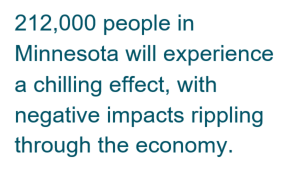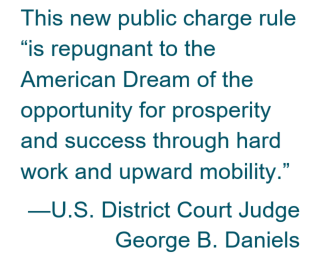A co-release from the Minnesota Budget Project and the Fiscal Policy Institute
In August 2019, the Department of Homeland Security published a final rule on the “public charge” ground of inadmissibility for immigrants whose application for a green card is processed in the United States. The rule applies a similar test to people seeking to extend or change their temporary status (such as student or employment visas) in the United States. Although scheduled to go into effect on October 15, the rule has been blocked temporarily by several federal courts.

If the new public charge rule goes into effect, it will make it much more difficult for low- and moderate-income families to make their lives in the United States if they are considered likely to use public benefits such as nutrition, housing and health care programs for which they may legally qualify. The Trump Administration’s version of the rule takes such a drastic view of what constitutes a benefit that if it were applied to the U.S.-born population—Americans who are not immigrants—roughly half might not be deemed acceptable to stay in the United States.[1] In addition to excluding people from being able to stay in the United States, the Minnesota Budget Project and the Fiscal Policy Institute predict that the rule will have a widespread chilling effect, with millions of immigrants who are eligible for support unnecessarily deterred from seeking critical services for themselves or their children. These programs help working families get through hard times, maintain their health and raise children who thrive.
Five courts found that plaintiffs are likely to succeed in arguing that the DHS rule is unlawful. The federal government is appealing these decisions and is seeking to lift the injunctions. But for now, and while these cases proceed, the rule is not being implemented. The longstanding public charge policy clarified in the 1999 Field Guidance remains in place.
Updating an analysis the Fiscal Policy Institute first published in 2018, we estimate that if the rule goes into effect, 212,000 people in Minnesota would experience a chilling effect from the public charge rule—anxiety and confusion about whether applying for public benefits will affect their immigration status or that of their family members. This “chilled” population includes everyone in a family with an immigrant who is not a naturalized citizen, and who is currently receiving one of the public benefits named in the rule. Among the people in the chilled population are 89,000 children under 18 years old, the large majority of whom (74,000) are U.S. citizens by birth. State-level analysis of the chilling effect is available in the table below for all 50 states and the District of Columbia.
Not everyone who is concerned about public charge will avoid enrolling in programs for which they qualify. Based on research available at the time, our central estimate in the 2018 report projected a 25 percent dropoff in enrollment, based on past experience.[2] An important survey conducted since that time has reinforced the appropriateness of that estimate. Even before the rule went into effect, the survey found, among immigrant families, 21 percent of adults in low-income families—the ones who would likely meet income eligibility requirements for most of these programs—reported that someone in their family avoided benefits.[3] Advocates and service providers will assuredly work closely with immigrants and their families to help them understand whether they are likely to face a public charge designation and which benefits may be considered. The projected dropoff rate takes this into account, since the past experience was also at a time when advocates and service providers worked to clarify the rules.

Looking only at health and nutrition supports, the two largest benefits named, this 25 percent drop in enrollment for the chilled population translates into $165 million in lost federal benefits across Minnesota. The loss of federal benefits in turn will create negative local economic ripple effects. Businesses such as grocery stores and supermarkets will lose income due to the decrease in SNAP participants. Hospitals, doctors and nurses will lose income with a reduction in Medicaid and CHIP. Many other businesses will lose revenue, as immigrant families that struggle to make up for the lost health care and nutrition benefits shift their spending priorities. This reduction in spending and income will result in lower investment and related job loss. The predicted loss to GDP is as much as $321 million, with a related loss of over 2,000 jobs lost, and $24 million in lost state tax revenue.
The human and economic impacts are large even if we use more conservative estimates about the chilling effect. It is possible, for example, that children’s use of Medicaid will decline less than that of adults, since the final rule clarifies that Medicaid use for children is not to be considered in public charge determinations.
In the more conservative estimate we assume that parents will recognize that CHIP and Medicaid for children are excluded from the public charge rule, and that there will be no drop in enrollment for children. Further, we assume that the dropoff rate for SNAP and for adults in Medicaid is 15 percent rather than 25 percent.
Even with these considerably more conservative assumptions, however, the human and economic impact remains very large. The projected loss in federal benefits is $79 million spread through the state. The projected decline in GDP due to economic ripple effects is as much as $151 million, and the projected job loss is over 1,000.
Judge George B. Daniels of the United States District Court of the Southern District of New York, was palpably offended by the new public charge rule. In the preliminary injunction that temporarily halts the rule from going into effect, Judge Daniels writes that members of the Trump Administration “do not articulate why they are changing the public charge definition, why this new definition is needed now, or why the definition set forth in the rule—which has absolutely no support in the history of U.S. immigration law—is reasonable. The rule is simply a new agency policy of exclusion in search of a justification.” The rule, Judge Daniels says further, “will punish individuals for their receipt of benefits provided by our government, and discourages them from lawfully receiving available assistance intended to aid them in becoming contributing members of our society.” And, he says, this new public charge rule “is repugnant to the American Dream of the opportunity for prosperity and success through hard work and upward mobility.”[4]
By David Dyssegaard Kallick, Cyierra Roldan and Clark Goldenrod
David Dyssegaard Kallick is deputy director of the Fiscal Policy Institute and director of FPI’s Immigration Research Initiative. Cyierra Roldan is a policy analyst for the Fiscal Policy Institute. Clark Goldenrod is the deputy director of the Minnesota Budget Project.
[1] Danilo Trisi, “Administration’s Public Charge Rules Would Close the Door to U.S. to Immigrants Without Substantial Means,” Center on Budget and Policy Priorities, November 11, 2019.
[2] Several studies led us to the 25 percent estimate. One worth noting in particular showed a drop in participation in public benefits programs after welfare and immigration law changes in the 1990s that was 26 percentage points greater for households with a non-citizen than it was for citizen households, a differential that can be attributed to the chilling effect for immigrants who were worried that making use of public benefits for which they qualified could create immigration status problems for themselves or other family members. See M.E. Fix and J.S. Passel, “Trends in Noncitizens’ and Citizens Use of Public Benefits Following Welfare Reform: 1994-1997,” Urban Institute, 1999.
[3] H. Bernstein, D. Gonzalez, M. Karpman, and S. Zuckerman, “One in Seven Adults in Immigrant Families Reported Avoiding Public Benefit Programs in 2018.” Urban Institute, 2019.
[4] State of New York, City of New York, State of Connecticut, and State of Vermont v. United States Department of Homeland Security, Secretary Kevin K. McAleenen, October 11, 2019. David Dyssegaard Kallick is an expert witness in the case.